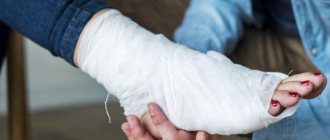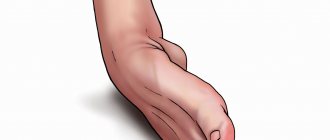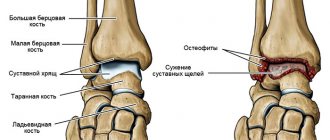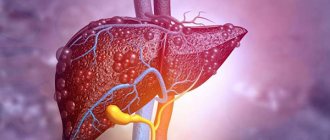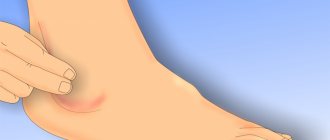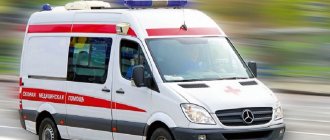An ankle sprain is a nasty sports injury in which a ligament is partially or completely torn. Such injuries are most often the result of traumatic effects on the ligamentous apparatus of the ankle joint. The damage may involve several ligaments at once, not just one.
The ArthroMedCenter Joint and Spine Clinic has been treating sports injuries for many years, using an innovative technique - MBST therapy - to restore damaged tissue.
The increased degree of injury to the ankle ligaments is due to the fact that the ankle joint is an extremely mobile joint, with a large degree of freedom of movement. The lower leg is constantly subjected to a load equal to the body weight (and when performing physical exercises, the weight increases even more). This injury is very common among athletes: if during training a person did not follow safety precautions and exercise technique, then he can damage the ligaments. However, this injury often occurs in everyday life, for example, due to simple carelessness: you can fall unsuccessfully.
MBST therapy
The ArthroMedCenter clinic offers a progressive treatment method aimed at restoring tissue after an ankle sprain - MBST therapy. MBST is a therapeutic magnetic resonance therapy used in clinical practice in the mode of several programs encoded on a chip card. Programs are designed to treat injuries and illnesses.
For ankle sprains, the course of treatment is 7 or 10 procedures, 1 hour per day. At this time, the patient lies on the device and “receives” the incoming energy without feeling discomfort.
There are 3-day programs prescribed to athletes after intense competitions and training, as well as to prevent damage to cartilage tissue. Magnetic resonance therapy uses energy that is produced by hydrogen atoms. In some way, sports injuries are treated with bioenergy, and its use is not associated with consequences for the body and the risk of complications. The procedure can be repeated.
Complications and prognosis
No injury goes away without a trace, especially when it comes to damage to ligaments, because the latter recover very slowly. Even a minor injury is fraught with serious complications, but after more severe injuries they occur even more often. These include:
- sprained ankle;
- flat feet;
- arthritis and arthrosis;
- tendonitis - inflammation of the tendons.
After mild to moderate sprains, the prognosis is generally favorable. In particularly severe cases, there is a high probability of an unfavorable prognosis, such as the development of lameness.
How does MBST work?
The principle of operation of this therapeutic method is based on the fact that tissue metabolism is regulated by electric and magnetic fields. And if in a healthy organ or system the processes of regeneration, that is, renewal, occur independently, then in case of dysfunction they require impulse influence from the outside. In MBST therapy, magnetic resonance is used as such an impulse, which sends signals to diseased tissues that reproduce signals from a healthy body system. Normalized metabolism allows you to resume the regeneration process in the cells of cartilage, bone tissue, tendons, etc. This allows you to eliminate the cause of disorders of the musculoskeletal system, and not only relieve the patient from the unpleasant symptoms of the disease.
Based on research, physicists and engineers were able to design equipment for the non-surgical treatment of sports injuries and diseases of the musculoskeletal system. Scientific and clinical studies have fully confirmed the restoration of cartilage using this method, and the method itself has been patented under the name MBST. This is the first and so far only therapeutic method that uses magnetic resonance for chronic and osteoarticular diseases. It has been officially approved for the treatment of osteoarthritis and osteoporosis and has been used for more than 15 years in Germany, Switzerland, Austria, Israel, Spain, Great Britain, Italy, Croatia, Romania, Slovenia, Czech Republic, and more recently in Turkey, Malaysia, the Philippines , in the Netherlands, in China and in India.
What other injuries can be treated with MBST?
Indications for using the MBST method:
- Achilles tendon injuries.
- Tendon injuries, partial tear of the medial collateral ligament of the knee, or tendinitis due to patellar tendon syndrome.
- Hip (muscle injuries).
- Knee joints (jumper's knee, cartilage and meniscus damage).
- As a conservative addition to cartilage wear/degradation and in cases after arthroscopy.
- Bone contusion/Bone swelling, osteochondritis dissecans or bone necrosis, pseudarthrosis, fractures and stress fractures.
Why does ankle sprain occur?
The ligamentous apparatus of the ankle can withstand quite serious loads, so in order to injure it, it is necessary to make an effort. An injury occurs at a time when the load is distributed incorrectly, that is, it is distributed not over several ligaments, but into one. As a result of overstrain, it stretches and breaks. Increased stress on the ankle ligaments can occur:
- when tucking the outer edge of the foot, the entire body weight will be distributed precisely over this area. In this case, injury occurs due to excessive supination of the leg;
- with maximum extension of the leg (while fixing the foot). In this case, injury occurs to the anterior talofibular and interfibular ligaments;
- in situations where the body weight is transferred to the forefoot (when it is fixed), and the lower leg is bent. In this case we are talking about an injury to the Achilles tendon.
- when the foot rotates (externally or internally), the foot is fixed. Ligaments are injured depending on the direction of the applied load - these can be internal or external ligaments, tendons of the peroneus brevis and longus muscles, etc. If we are talking about excessive internal rotation, the tendons of the tibialis posterior muscle can be damaged.
Types and degrees of ankle sprains
There are several types of injuries:
- turning the foot inward (inversion);
- turning the stoop outward (eversion);
- sprain of the upper ankle.
An ankle sprain can have several degrees of severity, which are distinguished based on the amount of damage to the ankle ligaments: The first degree is minor trauma. This type of injury is characterized by tearing of the fibers, but more than half of them remain intact. Treatment for such an injury does not last long, as does the rehabilitation period after it.
The second degree is a severe ankle sprain. Treatment in this case is more labor-intensive and lengthy than with the first degree of sprain. The second degree of severity is characterized by rupture of a significant part of the collagen fibers (about half). You can observe swelling of the injured area, as well as displacement of the articular elements.
Third degree - complete rupture of the ankle ligaments. There is pathological mobility in the joint, very pronounced swelling and pain in the injured area. It is important that immediately after receiving such an injury, first aid for an ankle sprain is provided, and then the person is taken to the clinic. This degree of severity is characterized by longer and more serious treatment. The rehabilitation process in this case also slows down.
What reasons lead to stretching?
The root cause of an ankle injury is the foot being in an incorrect position when it turns inward. There are other factors that lead to stretching:
- supination or high arch of the foot;
- underdeveloped foot and peroneal muscles, which often occurs against the background of intense training for other muscle groups, when the main focus is on the bench press and training on machines to the detriment of the lower extremities;
- contrary to the previous point, ligaments can weaken as a result of minimal human activity, which leads to their softening when the bones are poorly held together;
- size disproportion and disproportionate bone growth;
- disruption of the neuromuscular junction, which leads to involuntary ankle twisting;
- Having suffered minor sprains and sprains in the past, which makes the ankle unstable and weak.
Often, ligaments are subject to constant stretching in people who take steps incorrectly - turning or turning the foot inward or outward at a large degree. This type of walking habit weakens the ankle joint, and the ligaments inevitably become injured in the long run.
What is important for ankle ligament rehabilitation?
First aid for sprains
When spraining the ankle joint, timely first aid greatly influences the restoration of the tissues of the injured ligament and determines the time for complete restoration of joint function.
- First of all, apply ice wrapped in a towel (to prevent frostbite) to the injured ankle for 10-15 minutes, repeat the procedure after 15 minutes. Such manipulations will help not only relieve pain, but also stop the spread of edema (under the influence of cold, blood vessels reflexively narrow).
- The injured ankle must be kept at rest, and until an accurate diagnosis is made, you should not lean on the foot. Using a homemade or transport splint, you need to secure your leg. Fixation of the area should be maintained until examined by a traumatologist or surgeon.
- Place a bolster under your leg to give it an elevated position.
- Introduce an analgesic into the body (orally or by injection) if possible.
Treatment
Grade 1 and 2 sprains can be treated at home, and care is usually provided in an emergency room. Damage of the 3rd degree is treated inpatient conditions, in the trauma department.
General principles of therapy for sprains in all cases: rest, elevated position of the leg, immobilization of the joint, application of cold during the first days. After 3 days, dry heat can be used.
To immobilize the injured limb, use an ankle brace or a bandage with an elastic bandage. In particularly severe cases, immobilization with a plaster or plastic splint may be required.
If the ligament is completely torn, surgical treatment may be required. In other situations, they are limited to conservative measures: anti-inflammatory drugs such as ibuprofen, diclofenac, meloxicam are used to reduce pain and inflammation. It is possible to prescribe these same products for external use in the form of ointments and gels.
Physiotherapeutic procedures are recommended as additional treatment measures: UHF, paraffin baths, electrophoresis with painkillers.
When the condition improves, the limb is mobilized and therapeutic physical activity is prescribed. Special gymnastics are prescribed to help restore the previous mobility of the joint, improve blood circulation, restore the structure of the ligaments, and reduce pain. In addition, after prolonged immobilization, gymnastics helps strengthen muscles, restore their strength and build up lost muscle mass.
Symptoms of an ankle sprain
Symptoms of ankle sprains appear depending on the extent of the injury and the number of tendons involved in the injury mechanism. A complete rupture of the ankle ligaments is only caused by a sprain. This condition is characterized by excessive mobility in all projections of the joint. The main symptoms of an ankle sprain are:
- severe pain that occurs at the time of injury (fall, blow, etc.);
- swelling around the injured area (around the medial or lateral malleolus);
- bruising;
- extensive hematomas;
- local increase in temperature (in the injured area).
When trying to make a movement, a person also continues to experience pain.
Repeated ankle sprains lead to complete rupture of the tendon. More long-term and complex as well as longer rehabilitation will be required. That is why specialists at the ArthroMedCenter clinic recommend that you consult a doctor at the first sign of a sprain. To exclude repeated injuries, as well as the development of any other pathologies, it is worth carrying out a full course of treatment, including rehabilitation.
Injury rates
To determine what kind of injury has been received and whether it can be considered that the ankle ligaments are damaged, you should pay attention to the following symptoms:
- sharp pain after injury;
- joint deformity;
- pain and swelling that only gets worse;
- inability to stand on one's feet;
- hematomas.
If the injury occurred after a fall from a height or after a collision, the symptoms will be obvious.
Sprains and ruptures of the knee joint ligaments are accompanied by the following symptoms:
- after an injury, severe, acute pain immediately appears;
- edema;
- redness of the tissue around the injury;
- there is bleeding into the articular part;
- temperature increase;
- feeling of numbness.
Diagnosis of ankle sprains
The diagnosis of sprain is made based on the existing symptoms, as well as data from such studies as:
- magnetic resonance imaging (MRI);
- ultrasonic examination (ultrasound) of the joint;
- arthroscopy.
X-rays are not used to make a diagnosis, since the ligaments are a soft tissue formation, i.e. they are not visible on an X-ray. However, the patient may be referred for an x-ray to rule out a fracture. The symptoms of fractures and sprains are very similar, in addition, some symptoms can be combined with each other.
Medical rehabilitation
The main physiotherapeutic methods of rehabilitation are:
- cryotherapy course of 5-10 procedures;
- ultraviolet irradiation with a course of 5-10 procedures;
- magnetic therapy course of 5-10 procedures;
- UHF therapy course of 5-10 procedures;
- laser therapy course of 5-10 procedures.
To prevent atrophic changes in muscles and improve regional blood flow to the injured limb, use:
- isometric tension of the muscles of the thigh and lower leg for 5-7 seconds, 8-10 repetitions with a gradual increase in the intensity of the tension;
- active flexion and extension of the toes, lowering and raising the injured limb to improve peripheral blood circulation;
- ideomotor exercises to restore the dynamic stereotype.
Exercises for a favorable course of rehabilitation
- In the initial position, sitting or lying down, any letters of the alphabet are drawn with the injured heel. The more letters, the better.
- Tie one end of the elastic bandage to the foot, the other to a chair or table. You should slowly pull your foot towards you and then away from you for 1-2 minutes.
- Another option with an elastic bandage: keep your knee straight, slowly pull the tape towards you until you feel a stretch in the calf muscle. Hold the position for 15 seconds and do 15 repetitions.
- Stand one arm's distance from the wall. Place the injured leg behind the healthy one. Your toes should point forward in this position. Slowly bend your knees until you feel the calf muscle stretch. Hold the position for 15 seconds, relax, and then perform up to 20 repetitions.
Preventing ankle sprains
Ankle sprains can occur in anyone if they are not careful during exercise and outdoor activities. If you want to play sports, do it in suitable shoes and clothing. Walk carefully in high-heeled shoes, avoid potholes and potholes, and watch your step when walking somewhere. Try to fight excess weight, as obesity of any degree puts excessive stress on the joints. Lead an active lifestyle, play sports, eat well. Moderate physical activity strengthens.
How to treat a sprained ankle?
Physiotherapy
- The use of ultrasound - this procedure not only improves microcirculation of the damaged area, but also accelerates the process of lymph outflow. After this procedure, the ointments are absorbed much better, and the drug accumulates in the tissues.
- UHF is used to reduce local inflammation and accelerate reparative processes in tissues. Vasodilation helps improve the trophism of the affected area.
- Paraffin therapy is one of the main activities. The main effect of this therapy is to reduce pain and eliminate inflammatory processes. Can be used in any period after injury.
- Magnetic therapy – promotes the outflow of blood and lymph, enhances the absorption of local medications, and relieves inflammation.
- Electrophoresis with non-steroidal anti-inflammatory drugs or novocaine. Pain relief is achieved by dilating blood vessels.
Gymnastics
Any gymnastic exercises to strengthen the ankle joint can only be performed in the long term (about 1-3 months, depending on the degree of injury).
- Development of motor skills of the toes.
- Rolling a bottle with your foot.
- Walking on your heels.
- Running on small pebbles or sand.
- Circular rotations of the foot.
- Extension and flexion of the leg at the ankle joint.
- Walking on the outside and inside of the foot.
- Walk on your toes for a few minutes every day.
Physiotherapy
If the ankle is sprained, UHF therapy is prescribed. Alternating currents dilate blood vessels and accelerate regenerative processes.
- The effect of ultrasound is comparable to micromassage. The technology relieves inflammatory reactions and reduces the sensitivity of nerve receptors in the affected area.
- Paraffin applications have an analgesic and stimulating effect.
- Alternating different-frequency currents in diadynamic therapy is used for pain blockade.
- Hardware massage enhances the effect of procedures, relieves muscle spasms, and improves nutrition of soft tissue structures.
